I was playing with fractals recently and discovered a fun way to construct the Koch snowflake. It may not be new to the world, given how much is known about fractals, but it was new to me. In any case, it’s really cool! It lets you see a lot more interesting self-similarity in this fractal, and effortlessly leads to the known tilings of the plane by Koch snowflakes.
The Koch snowflake is usually constructed starting with an equilateral triangle by replacing the middle third of each side with an equilateral triangular protrusion, doing this again to the resulting polygon, and so on. The first seven steps are shown in this animation:
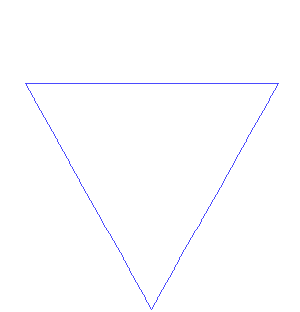
and the Koch snowflake is the “limit” of this process as the number of steps goes to infinity.
In the alternative construction we use only self-replicating triangles. We again start with a triangle:
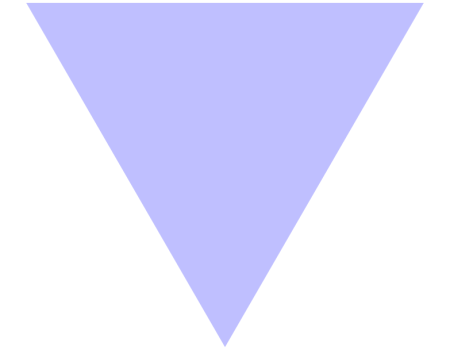
But now, rather than modifying this triangle, we let it “reproduce,” yielding six new triangles, three at the corners of the original, and three sticking out from the sides of the original. I’ll make the six offspring a bit darker than the original so that you can see them all:
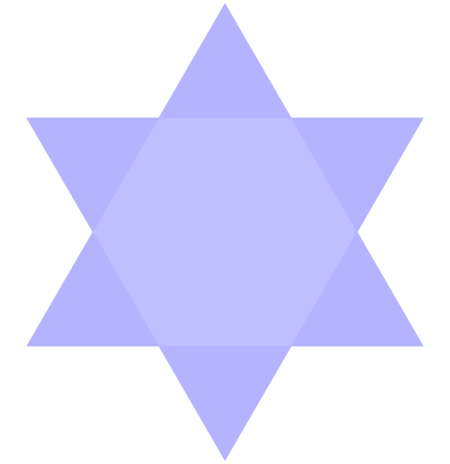
Notice that three of the children hide the corners of their parent triangle, so it looks like we now have a hexagon in the middle, but really we’ve got one big triangle behind six smaller ones. Now we do the same thing again, letting each of the six smaller triangles reproduce in the same way:
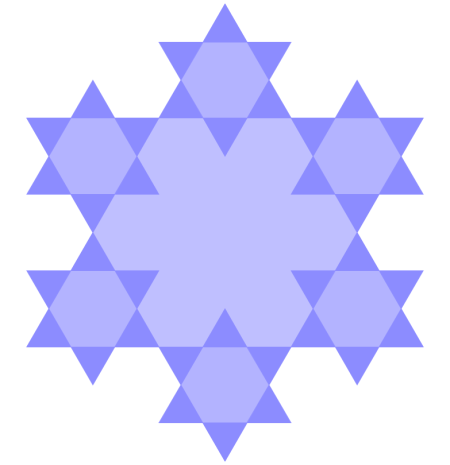
The 36 small triangles are the “grandchildren” of the original triangle; if each of these has six children of its own, we get:
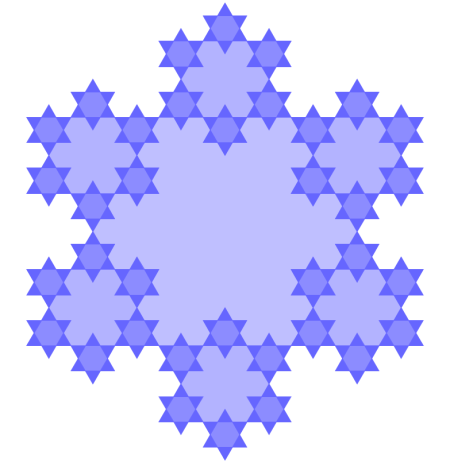
Repeating this again:
 And again:
And again:
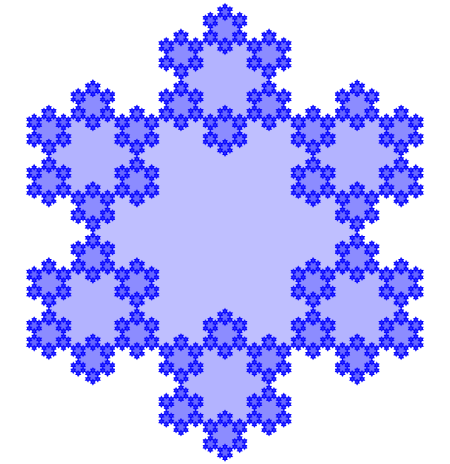
At this stage, it starts getting hard to see the new triangles, so I’ll stop and rely on your imagination of this process continuing indefinitely. We can now see some interesting features emerging. Here are some of the main ones:
- The outer perimeter of all of these triangles, taken to the infinite limit, is the Koch snowflake.
- The lightest blue region, in the middle, is also converging to a smaller Koch snowflake, rotated from the outer one by
.
- Between the outer perimeter and the Koch snowflake in the middle are six more yet smaller Koch snowflakes.
- The regions in the middle of these snowflakes are also Koch snowflakes …
and so on: we have Koch snowflakes repeating at smaller and smaller scales.
All this self similarity shows in particular that Koch snowflakes can be assembled out of Koch snowflakes. This is nothing new; it’s related to Aidan Burns’ nice demonstration that Koch snowflakes can be used to tile the plane, but only if we use snowflakes of at least two different sizes:
Aidan Burns, Fractal tilings. Mathematical Gazette 78 No. 482 (1994) 193–196.
These tilings are already visible in the above construction using triangles, but we can make them even more evident by just playing with the color scheme.
First, if we draw the previous picture again but make all of the triangles the same color, we just get a region whose perimeter is the usual Koch snowflake:
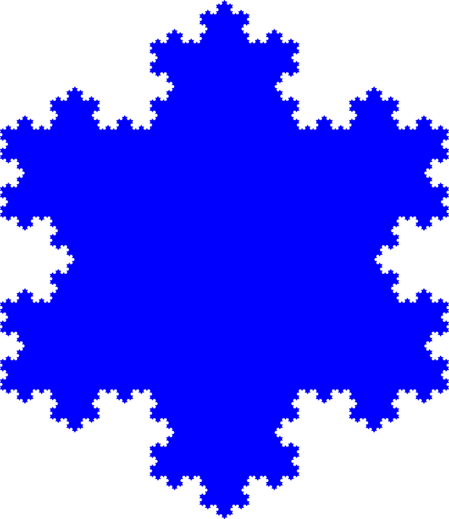
On the other hand, if we make the original triangle white, but all of its descendants the same color of blue, we get this:

I hope you see how this forms part of a wallpaper pattern that could be extended in all directions, adding more blue snowflakes that bound larger white snowflake-shaped gaps. This gives the tiling of the plane by Koch snowflakes of two different sizes.
Taking this further, if we make the the original triangle and all of its children white, but all of their further descendants the same color of blue, we get this:

The pattern seen here can be extended in a hopefully obvious way to tile the whole plane with Koch snowflakes of three different sizes.
Going further, if we make the first three generations white, but all blue after that, we get:
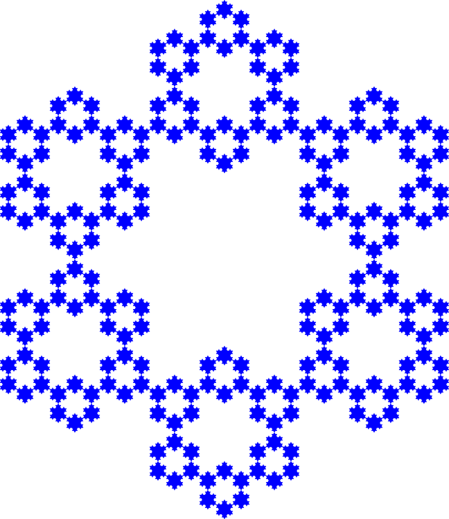
and so on.
The previous four pictures are generated with exactly the same code—we’re drawing exactly the same triangles, and only changing the color scheme. If we keep repeating this process, we get a tiling with arbitrarily small Koch snowflakes!
But we can also go the other way, continuing up in scale to get a tiling that includes arbitrarily large Koch snowflakes. To do this, we just need to view the above series of pictures in a different way!
The way I described it, the scale is the same in all of the previous four pictures. Making successive generations white, one generation at a time, makes it look as if we’re cutting out a snowflake from the middle of a big snowflake, leaving six similar snowflakes behind, and then iterating this:

On the other hand, we can alternatively view these pictures as a process of zooming out: each picture is built from six copies of the previous one, and we can imagine zooming out so that each picture becomes just one small piece of the next.
If you’re careful about how you do this, you get a tiling of the whole plane, with arbitrarily large Koch-snowflake shaped tiles! I say you have to be careful because it won’t cover the whole plane if, for example, each picture becomes the top middle part of the next picture. But, if you zoom out in a “spiral,” rotating by at each step, you’ll get a tessellation of the plane.
Someone should make an animation that shows how this works. Maybe I’ll get a student to do it.
There are some other fun variations on this theme—including a similar construction that leads to the other “fractal tiling” described by Aidan Burns—which I should explain in another post.
In case anyone wants it, here is a 1-page visual explanation of the construction described in this post: snowflake.pdf
(All images in this post, except for the first, copyright 2017 Derek Wise.)
11 May 2018 at 11:13 |
[…] by seven new triangles. This is the sixth generation. The construction differs only slightly from my previous Koch snowflake fractal, in which each triangle had six descendants. I really like this new version, because you can see […]
19 February 2019 at 17:55 |
[…] smaller scales. This is just the fractal that I’ve written about before, starting with “Fun with the Koch Snowflake” which I wrote when I first discovered it. It’s like a “Sierpinski Koch […]
4 November 2019 at 07:05 |
[…] https://dkwise.wordpress.com/2017/06/22/fun-with-the-koch-snowflake/ […]
3 April 2022 at 23:28 |
[…] La décomposition d’un flocon de neige comme forme fractale. Source […]